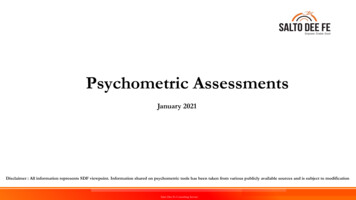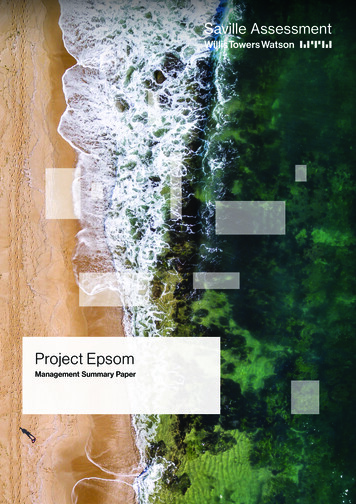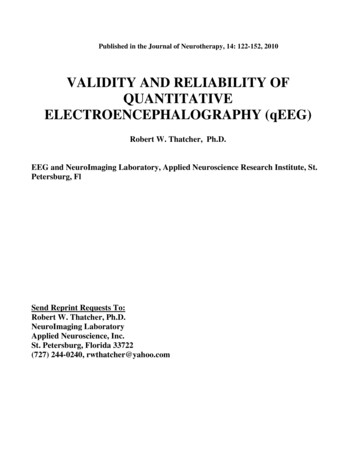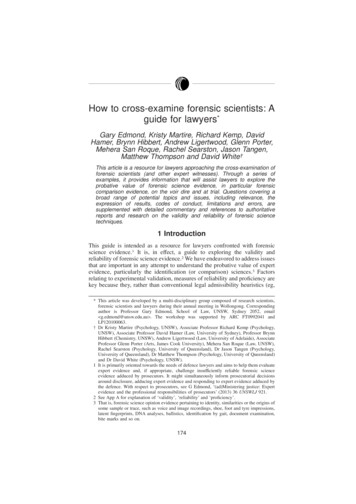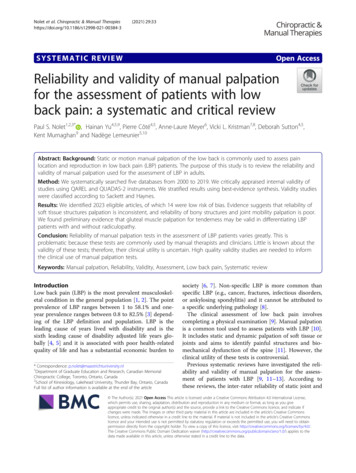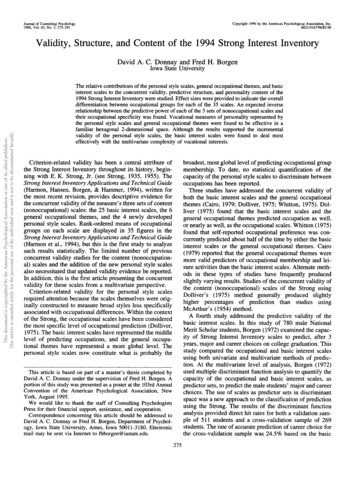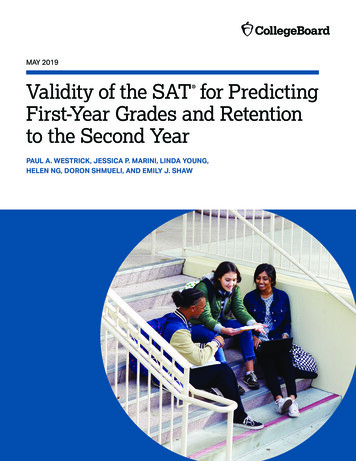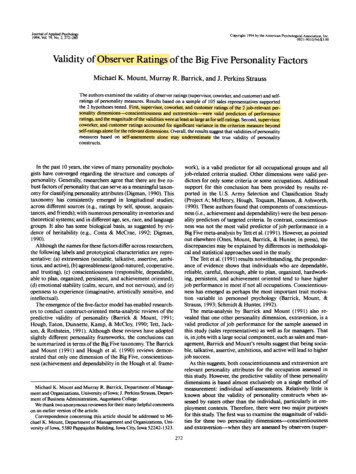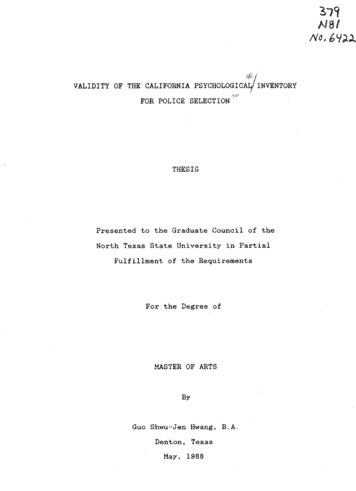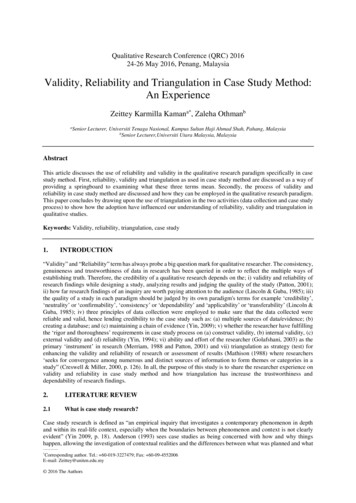
Transcription
Qualitative Research Conference (QRC) 201624-26 May 2016, Penang, MalaysiaValidity, Reliability and Triangulation in Case Study Method:An ExperienceZeittey Karmilla Kamana*, Zaleha OthmanbaSeniorLecturer, Universiti Tenaga Nasional, Kampus Sultan Haji Ahmad Shah, Pahang, MalaysiabSenior Lecturer,Universiti Utara Malaysia, MalaysiaAbstractThis article discusses the use of reliability and validity in the qualitative research paradigm specifically in casestudy method. First, reliability, validity and triangulation as used in case study method are discussed as a way ofproviding a springboard to examining what these three terms mean. Secondly, the process of validity andreliability in case study method are discussed and how they can be employed in the qualitative research paradigm.This paper concludes by drawing upon the use of triangulation in the two activities (data collection and case studyprocess) to show how the adoption have influenced our understanding of reliability, validity and triangulation inqualitative studies.Keywords: Validity, reliability, triangulation, case study1.INTRODUCTION“Validity” and “Reliability” term has always probe a big question mark for qualitative researcher. The consistency,genuineness and trustworthiness of data in research has been queried in order to reflect the multiple ways ofestablishing truth. Therefore, the credibility of a qualitative research depends on the; i) validity and reliability ofresearch findings while designing a study, analyzing results and judging the quality of the study (Patton, 2001);ii) how far research findings of an inquiry are worth paying attention to the audience (Lincoln & Guba, 1985); iii)the quality of a study in each paradigm should be judged by its own paradigm's terms for example ‘credibility’,‘neutrality’ or ‘confirmability’, ‘consistency’ or ‘dependability’ and ‘applicability’ or ‘transferability’ (Lincoln &Guba, 1985); iv) three principles of data collection were employed to make sure that the data collected werereliable and valid, hence lending credibility to the case study such as: (a) multiple sources of data/evidence; (b)creating a database; and (c) maintaining a chain of evidence (Yin, 2009); v) whether the researcher have fulfillingthe ‘rigor and thoroughness’ requirements in case study process on (a) construct validity, (b) internal validity, (c)external validity and (d) reliability (Yin, 1994); vi) ability and effort of the researcher (Golafshani, 2003) as theprimary ‘instrument’ in research (Merriam, 1988 and Patton, 2001) and vii) triangulation as strategy (test) forenhancing the validity and reliability of research or assessment of results (Mathison (1988) where researchers‘seeks for convergence among numerous and distinct sources of information to form themes or categories in astudy” (Creswell & Miller, 2000, p. 126). In all, the purpose of this study is to share the researcher experience onvalidity and reliability in case study method and how triangulation has increase the trustworthiness anddependability of research findings.2.LITERATURE REVIEW2.1What is case study research?Case study research is defined as “an empirical inquiry that investigates a contemporary phenomenon in depthand within its real-life context, especially when the boundaries between phenomenon and context is not clearlyevident” (Yin 2009, p. 18). Anderson (1993) sees case studies as being concerned with how and why thingshappen, allowing the investigation of contextual realities and the differences between what was planned and what*Corresponding author. Tel.: 60-019-3227479; Fax: 60-09-4552006E-mail: Zeittey@uniten.edu.my 2016 The Authors
Proceedings of the 2nd UUM International QUALITATIVE RESEARCH CONFERENCE 201624-26 May 2016. Penang, MalaysiaAvailable online at www.qualitative-research-conference.comactually occurred. Case study is not intended as a study of the entire organization. Rather is intended to focus ona particular issue, feature or unit of analysis. In order to understand and examine the processes of training activitiesin organizations, case study method was chosen. This method enables me to understand the complex real-lifeactivities in which multiple sources of evidence were used. The used of case study to probe an area of interest indepth is particularly appropriate as described by Patton (1987), that case studies become particularly useful whereone needs to understand some particular problem or situation in great-depth, and where one can identify cases richin information.2.2Reliability and validity in case study researchAlthough the term ‘Reliability’ is a concept used for testing or evaluating quantitative research, the idea is mostoften used in all kinds of research. The most important test/strategy of any qualitative study is its quality. A goodqualitative study can help us “understand a situation that would otherwise be enigmatic or confusing” (Eisner,1991, p. 58).On the other hand, Patton (2001) states that validity and reliability are two factors which any qualitative researchershould be concerned about while designing a study, analyzing results and judging the quality of the study. Thiscorresponds to the question that “How can an inquirer persuade his or her audiences that the research findings ofan inquiry are worth paying attention to?" (Lincoln & Guba, 1985, p. 290). To answer to the question, Healy andPerry (2000) assert that the quality of a study in each paradigm should be judged by its own paradigm's terms. Forexample, while the terms Reliability and Validity are essential criterion for quality in quantitative paradigms, inqualitative paradigms the terms Credibility, Neutrality or Confirmability, Consistency or Dependability andApplicability or Transferability are to be the essential criteria for quality (Lincoln & Guba, 1985).The concept of validity is described by a wide range of terms in qualitative studies. This concept is not a single,fixed or universal concept, but “rather a contingent construct, inescapably grounded in the processes and intentionsof particular research methodologies and projects” (Winter, 2000, p.1). Additionally, Lincoln and Guba (1985)states that: "Since there can be no validity without reliability, a demonstration of the former [validity] is sufficientto establish the latter [reliability;]" (p. 316). Patton (2001) with regards to the researcher's ability and skill in anyqualitative research also states that reliability is a consequence of the validity in a study.Yin (2009) proposed three (3) principles of data collection to deal with the problems of establishing the constructvalidity and reliability of the case study evidence which are; (1) multiple sources of evidence; (2) create a casestudy database; and (3) maintain a chain of evidence. With regards to rigour and thoroughness in case studyprocess, the elements of construct validity, internal validity, external validity and reliability is the strategy used toenhance the validity and reliability issue (Yin, 1994, 2009, 2012).2.3Triangulation in case studyTriangulation is defined to be “a validity procedure where researchers search for convergence among multiple anddifferent sources of information to form themes or categories in a study” (Creswell & Miller, 2000, p. 126).Triangulation is typically a strategy (test) for improving the validity and reliability of research or evaluation offindings. Mathison (1988) elaborates this by saying: ‘Triangulation has risen an important methodological issuein naturalistic and qualitative approaches to evaluation [in order to] control bias and establishing valid propositionsbecause traditional scientific techniques are incompatible with this alternate epistemology’ (p. 13).Engaging multiple methods, such as, observation, interviews and documents review (Yin, 1994, 2009) will leadto more valid, reliable and diverse construction of realities. To improve the analysis and understanding ofconstruction of others, triangulation is a step taken by researchers to involve several investigators or peerresearchers’ interpretation of the data at different time or location. In a related way, a qualitative researcher can“use investigator triangulation and consider the ideas and explanations generated by additional researchersstudying the research participants” (Johnson, 1997, p.284).Triangulation may include multiple methods of data collection and data analysis, but does not suggest a fix methodfor all the researches. The methods chosen in triangulation to test the validity and reliability of a study depend onthe criterion of the research (Golafshani, 2003). Patton (2002) discusses four types of triangulations in doingevaluations, data triangulation, investigator triangulation, theory triangulation and methodological triangulation.351
Proceedings of the 2nd UUM International QUALITATIVE RESEARCH CONFERENCE 201624-26 May 2016. Penang, MalaysiaAvailable online at www.qualitative-research-conference.comYin (2009) advocates that triangulation in case study method have a major strength for example, the researcherhave the opportunity to use many different sources of evidence in data collection. Furthermore, the need to usemultiple sources of evidence far exceeds that in other research methods, such as experiments, surveys, or histories.3.METHODA single case study was conducted in one of the leading petrochemical companies in Malaysia. A pseudonym isused to describe the company, which is referred to as ‘Company A’. The company is a petrochemical plant innature. Company A and group-wide established a big conglomerate of chemical producer in Malaysia. Thebusiness activities include (i) the exploration, development and production of the refining and marketing ofpetroleum products; (ii) the manufacture and sale of petrochemical products; (iii) the trading of crude oil, naturalgas, LNG, petroleum products and petrochemical products; and (iv) shipping and logistics relating to LNG, crudeoil and petroleum products. As the leading integrated chemical producer in Malaysia with a total combinedproduction capacity of over 10 million metric tons per annum (mtpa), Company A and the group-wide entityinvolve primarily in manufacturing, marketing and selling a diversified range of chemical products, includingammonia commercially, as well as supplying carbon monoxide (CO) and oxogas (a mixture of hydrogen and CO),olefins, polymers, fertilizers, methanol and other basic chemicals and derivative products.Company A was chosen as a case to be studied in the present research for five reasons, discussed below:(i) First, a single case can contribute significantly contribution to knowledge and theory building (the studywas conducted on how company A implemented its corporate social responsibility (CSR) towardsenvironmental protection in Malaysia).(ii) Secondly, Company A was chosen because the case represented an extreme or unique case. Problemsolving will only be found by investigating a single case study. This was achieved by examining the CSRgreen practices through EMS ISO14001 in Company A, which could not be possible if the study were tobe conducted in any type of company.(iii) Thirdly, a single case study was employed in Company A because it was ‘representative’ of a ‘typicalcase’. Company A is one of the big conglomerates of 25 chemical companies in Malaysia. Therefore, asmentioned by Yin (2009), Company A was ‘representative’ of a ‘typical case’. Thus, the everydaycircumstances in Company A and group-wide entity could be said to be similar. Additionally, amanufacturing firm is typical of other manufacturing firms within the same industry. A chemicalcompany that produces Ammonia, Carbon dioxide and Oxogas has therefore similar manufacturingactivities.(iv) Fourthly, the single case was conducted in Company A because it was a revelatory case. This situationexisted when the researcher had an opportunity to observe and analyze a phenomenon previouslyinaccessible to scientific observation. The case study was therefore worth conducting because the “firsthand” information would be revelatory.(v) Lastly, a single case involves a “prolonged engagement and persistent observation in the field” (Creswell,2007). During data collection process, the researcher managed to be engaged in field and madeobservation by doing the following: building trust with participants, learning the organizational culturein Company A, checking for misinformation that could stem from distortions introduced by theresearcher and informants, and making decision about what was salient to the study, relevant to thepurpose of the study and of interest.4.FINDINGSValidity and reliability of research findings has been met through triangulation procedure in the study. Accordingto Yin (1994), as in all research, consideration must be given to construct validity, internal validity, externalvalidity, and reliability. He suggested using multiple sources of evidence as the way to ensure construct validity(i.e., the study used multiple sources of evidence; survey instruments, interviews, and documents). In this article,the researcher share her experience on validity and reliability of case study method based on recommendation byYin (1994).352
Proceedings of the 2nd UUM International QUALITATIVE RESEARCH CONFERENCE 201624-26 May 2016. Penang, MalaysiaAvailable online at www.qualitative-research-conference.comThe study shows that the trustworthiness and accountability of findings was achieved over; (i) data collectionstage and (ii) throughout case study process.4.1Validity and reliability of data: Data collection activityThree principles of data collection were employed to make sure that the data collected were reliable and valid,hence lending credibility to the case study. They are: (a) multiple sources of data/evidence; (b) creating a database;and (c) maintaining a chain of evidence (Yin, 2009).Firstly, the researcher used multiple sources of data to converge the findings. The sources of data in this studywere Company A’s ‘internal documents’ such as the Environmental Impact and Aspect procedure, HazardousSpillage Management, and HSE communication procedure1, which were later triangulated with interviews withkey informants and direct observations. The use of multiple sources of data in this study allowed the researcherto address a broader range of CSR practices in Company A (i.e. the data revealed two types of CSR practices inCompany A: philanthropy orientation on societal needs and biodiversity concern, and internal CSR on EMSISO14001 green practice). With the use of multiple sources, the researcher was able to explore the transformationof CSR practices in Company A from the philanthropy motive to the EP objective which was being practicedsimultaneously. In short, through the use of multiple sources of data, a line of inquiry was converged. The processof triangulation where data from documents, interviews and direct observation were corroborated enhanced thevalidity and credibility of the findings obtained. With data triangulation, the potential problem of construct validitywas addressed because the multiple sources of evidence essentially provided multiple measures of the samephenomenon.Secondly, a case study database assisted the researcher in organizing and documenting the data collected. A casestudy database represents a formal assembly of evidence distinct from the final case study report (Yin, 2009). Thiswas done by separating the following documents: data gathered from Company A, and the personal notes/reportof the researcher (i.e. in article, report or book form). These documents were stored in different places todistinguish them from each other. For example, the data from Company A (i.e. environmental monitoringprocedure and schedule waste management documents) were placed in box 1 and the report of the researcher inbox 2 (i.e. refer to the secondary analysis conducted by the researcher). Such documentation was to develop aformal, presentable database for review by other researchers/investigators, if needed. In this sense, a case studydatabase increased the reliability of the entire case study.Lastly, a chain of evidence was employed to achieve reliability of the case study. A chain of evidence explicitlylinks among the questions asked, the data collected, and the conclusions drawn. The steps conducted in this studywere as follows:i) The researcher referred to specific documents in Company A (i.e. Environmental monitoring and HSEcommunication procedure), conducted interviews with key informants no 1, no 2 and no 3, and made fieldobservations in Company A’s chemical plant;ii) The database stored the empirical evidence (i.e., first hand’s information on environmental initiatives by keyinformant 1, key informant 2 and key informant 3) and indicated the circumstances under which the evidencewas collected.iii) The previous circumstances mentioned in this study were consistent with the specific procedures and questionscontains in the case study protocol to show that the data collection had followed the procedures stipulated bythe protocol (i.e., through triangulation over interviews, documents review and observations at company A).iv) Finally, a reading of protocol indicated the link between the content of the protocol and the initial studyquestions (represented in research questions on; (1) What is the current CSR practices related to environmentalprotection? and (2) How CSR practices are integrated in the EMS ISO14001 in regards to environmentalprotection? Therefore, the cross-referencing in the methods and techniques was to ascertain construct validityand reliability of the case study findings.353
Proceedings of the 2nd UUM International QUALITATIVE RESEARCH CONFERENCE 201624-26 May 2016. Penang, MalaysiaAvailable online at www.qualitative-research-conference.com4.2Rigour and thoroughness in case study processRigor and thoroughness was met by the following procedure: (a) validation and confirmation by key informantno 1, no 2, and no 3 in Company A. The early conceptual framework established was sufficient to explainCompany A’s environmental protection objective; (b) certification by SIRIM Berhad on EMS ISO14001 inCompany A; and (3) verification letter by DOE Malaysia on Company A’s lawful conduct. To validate andascertain the reliability of the study, four tests were used (Yin, 2009). The tests/ strategy are explained below:Table 1: Rigor and thoroughness in case study process: Validation, reliability and triangulationTests/ StrategyCase study tactics1) Construct validity- The researcher identifiedcorrect operational measures ofthe concepts studied i.e., basedon; (1) preliminary study and(2) the proposed conceptualframework by Husted (2000)and Gandhi et al (2006).- The researcher used multiple sources of data bytriangulating data from interviews, document reviews,direct observation and participant observation.- The researcher established chain of evidence (i.e.,presented the evolution of CSR practice in Company Afrom previous philanthropy motive to contemporarygreen practice objective).- Have key informant reviewed the draft of case studyreport (i.e., in this case, key informant no 1 reviewedthe report on data analysis during data collection). Data collection Data collection Member’s checking- Do pattern matching (i.e. comparing an empiricallybased pattern with the predicted one. If the patternscoincide, the results can help strengthen the internalvalidity of the case study.- For instance, the researcher added a new variable(corporate reputation as one of the forces ofenvironmental protection objective) during thepreliminary study.- Another example, she predicted a pattern of specificvariables prior to data collection (i.e. decision makingand information flow began from EMS ISO14001, notfrom the company’s structure as proposed in theprevious conceptual framework). Data analysis- To validate and confirm the findings on environmentalprotection by Company A, certification and recognitionwas given by SIRIM QAS International and DOEMalaysia for approval of Company A lawful conducttowards environmental protection. Research design- Use a case study protocol from multiple sources ofdata from interviews, documents and observation.- Develop a case study database (chain of evidence sothat the audience understands the flow of events in thecase study reporting).- The goal of reliability is to minimize errors and biasesin a study. Data collection Data collection2) Internal validity- Establish an associationbetweenvariables/determinants. This because thisstudy had mapped the researchdesign with the conceptualframework based on previousworks (Husted, 2000; Gandhi etal., 2006).3) External validity- Define external validity,which refers to the recognitionfrom the policy maker, namely,SIRIM QAS International andthe Department of EnvironmentMalaysia.4) Reliability- Demonstrate that the studycan be replicated in terms ofdata collection with the sameresults obtained.Triangulation procedureSource: Adopted by Case Study Research: Design and Methods, 4th edition, Robert K.Yin, 2009354
Proceedings of the 2nd UUM International QUALITATIVE RESEARCH CONFERENCE 201624-26 May 2016. Penang, MalaysiaAvailable online at NTriangulation Datacollectionstage Case studyprocess i) Data collection-threeprinciple ii) Research design- fourtest/strategyValidity Research findingsare credible andrepresentsconsistency,dependability andaccountabilityRealibilityFigure 1: Validity and reliability in case study method through triangulation procedureA holistic approach on validity and reliability through triangulation procedure have increase the trustworthinessand dependability of research. In this study the researcher adopts validity and reliability procedure to achievequality and credible research findings. As describe by figure 1, validity process can be seen in two levels wherebythey were represented during (i) data collection at company A i.e, a) using multiple sources of data/evidence; b)creating a database; and c) maintaining a chain of evidence (Yin, 2009); and (ii) rigour and thoroughness of casestudy process in research (i.e, test on construct validity, internal validity, external validity and reliability). Thevalidity protocol as proposed by Yin (2009) has been followed by the researcher so no issue of validity occurred.Scholars has defined validity as a result the reliability of a qualitative study (Lincoln & Guba, 1985; Patton, 2001).Therefore by adopting these two terms, triangulation has increased the credibility of findings. This is proven whenthe researcher has employed triangulation procedure; (i) during data collection process (i.e, over interviews withkey informant 1, key informant 2 and key informant 3 at company A, documents reviewed-company A documents,annual report, and sustainability reports and observations at company A chemical plants and administrationoffice). Therefore, the researcher realized that a major strength of case study data collection is the opportunity touse many different source of evidence. This is proven when the researcher has an opportunity to emerge themultiple source of evidence into the development of converging lines of inquiry technique. As mentioned by Yin(1994, 2009), the converging lines of inquiry is a “process of triangulation and corroboration emphasizedrepeatedly” (page 116) so that, any case study findings or conclusion is likely to be more convincing and accuratebased on several different sources of information, following a corroboratory mode. For example, the researchertriangulated the data of the case study (i.e., interviews, document reviews and observations) and corroboratedthem at the same fact or phenomenon. Thus, the analysis of case study method were rated more highly, in termsof their overall quality than those that relied on only single sources of information (Yin, 2009).In addition, validity and reliability process of case study has proven when the researcher adopt rigour andthoroughness in the research design. They were four (4) strategy/test that has been used in the study; (1) constructvalidity, (2) internal validity), (3) external validity, and (4) reliability (Yin, 2009). The techniques wererepresented as follow;(1) Construct validity: The researcher identified correct operational measures of the concepts studied i.e., basedon (1) preliminary study and (2) the proposed conceptual framework by Husted (2000) and Gandhi et al (2006).This is takes place in data collection and member’s checking stage.(2) Internal validity: the researcher established an association between variables/ determinants. This because thisstudy had mapped the research design with the conceptual framework based on previous works (Husted,2000; Gandhi et al., 2006). In this sense, triangulation occurred in data analysis stage. The triangulationprocess begins when the researcher engaged members’ checking procedure reviewing the draft of case studyreport on data analysis.355
Proceedings of the 2nd UUM International QUALITATIVE RESEARCH CONFERENCE 201624-26 May 2016. Penang, MalaysiaAvailable online at www.qualitative-research-conference.com(3) External validity: the researcher outlines external validity, which refers to the recognition from the policymaker, namely, SIRIM QAS International and the Department of Environment Malaysia. Therefore,triangulation process takes place when the researcher getting third party approval by validating andconfirming the findings on ethical environmental protection by Company A with Department ofEnvironmental Malaysia (DOE), therefore certification and recognition was awarded by SIRIM QASInternational and DOE Malaysia to company A for approving the lawful conduct towards environmentalprotection.(4) Reliability: Demonstrate that the study can be replicated in terms of data collection with the same resultsobtained. The triangulation process takes place when the researcher adopts a case study protocol frommultiple sources of data from interviews, documents and observation. This is proven when researcher developa case study database (chain of evidence so that the audience understands the flow of events in the case studyreporting). This is because, the goal of reliability is to minimize errors and biases in a study.As a result, by following all procedures on validity, reliability and triangulation process (Yin, 1994; 2009) researchfindings in the case study at company A was deemed as credible and represents consistency, dependability andaccountability. Therefore, the issues of reliability, validity, trustworthiness, quality and rigor are meantdifferentiating a 'good' from 'bad' research then increasing the reliability, validity, trustworthiness, quality andrigor will be important to the research in qualitative paradigm (Golafshani, 2003).6.CONCLUSIONFrom the foregoing discussion, reliability and validity are conceptualized as trustworthiness, rigor and quality inqualitative paradigm. From the qualitative researchers’ perspectives, validity and reliability terms are adopted toeliminate bias and increase the researcher’s truthfulness about some social phenomenon (Denzin, 1978) and thisis employed through triangulation procedure. Therefore, reliability, validity and triangulation, if they are to berelevant research concepts, particularly from a qualitative point of view, have to be embraced particularly in casestudy protocol, as we have seen before in order to reflect the multiple ways of establishing truth. Overall, thefindings indicates similar validity, reliability and triangulation procedures recommended by Yin (1994 & 2009).Nonetheless, there are additional criteria employed that contributes and advance the validity criteria comparablewith Yin (1994; where the researcher employed Creswell (2007) prolong engagement and persistent observationin the field rather than applying Yin (1994 & 2009) recommended on longitudinal study of the company.REFERENCESAnderson, G. (1993). Fundamentals of Educational Research. Falmer Press, London, pp: 152-160.Creswell, J. W. & Miller, D. L. (2000). Determining validity in qualitative inquiry. Theory into Practice, 39(3), 124-131.Creswell, J. W. (2007). Qualitative inquiry \& research design: Choosing among five approaches. Inc Sage Publications.Denzin, N. K. (1978). The research act: A theoretical introduction to sociological methods. New York: McGraw-Hill.Eisner, E. W. (1991). The enlightened eye: Qualitative inquiry and the enhancement of educational practice. New York, NY: MacmillanPublishing Company.Gandhi, N.M.D., Selladurai, V. and P. Santhi, P. 2006.Unsustainable development to sustainable development: A conceptual model.Management of Environmental Quality: An International Journal 17(6): 654-672.Golafshani, N. (2003). Understanding Reliability and Validity in Qualitative Research. The Qualitative Report Volume 8 Number 4December, pp: 597-607Healy, M., & Perry, C. (2000). Comprehensive criteria to judge validity and reliability of qualitative research within the realism paradigm.Qualitative Market Research, 3(3), 118-126.Husted, B.W. and Allen, D.B. 2006. Corporate social responsibility in the multinational enterprise: strategic and institutional approaches.Journal of International Business Studies. 37: 838-849.Johnson, B. R. (1997). Examining the validity structure of qualitative research. Education, 118(3), 282-292.Lincoln, Y. S., & Guba, E. G. (1985). Naturalistic inquiry. Beverly Hills, CA: SageMathison, S. (1988). Why triangulate? Educational Researcher, 17(2), 13-17.Merriam, S. 1998. Qualitative research and case study applications in education. San Francisco (USA).Patton, M. Q. (2002). Qualitative evaluation and research methods (3rd ed.). Thousand Oaks, CA: Sage Publications, IncPatton, M.Q (1987). How to Use Qualitative Methods in Evaluation. Sage Publication, California, pp: 18-20.Patton, MQ. (2001). Qualitative Research and Evaluation Methods (2nd Edition). T
Proceedings of the 2nd UUM International QUALITATIVE RESEARCH CONFERENCE 2016 24-26 May 2016. Penang, Malaysia Available online at www.qualitative-research-conference.com 352 Yin (2009) advocates that triangulation in case study method have a major strength for example, the researcher
